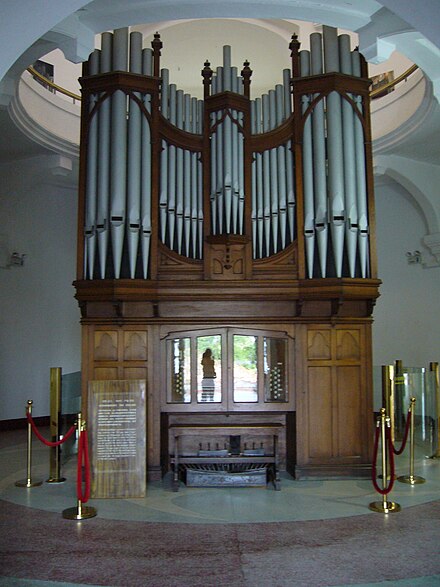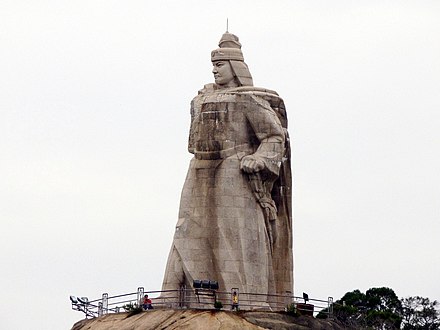Gulangyu - island of China
Gulangyu (鼓浪屿 Kó͘-lōng-sū in Minnan, Gǔlàngyǔ in Mandarin) is an island in Xiamen, a few minutes by ferry from downtown. It has a population around 17,000 and an area of about 2 km² (500 acres). It was a foreign enclave from the 1840s until the 1930s, and is now both a residential suburb and a major tourist area. In 2017 it was inscribed as a .
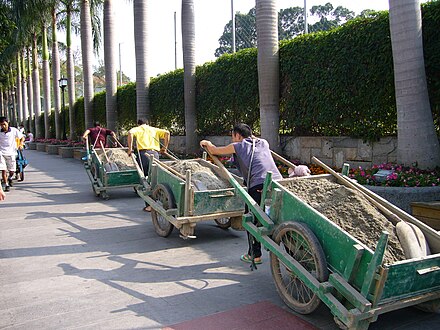
The island is extremely popular with Chinese tourists, who arrive in droves, often in large tour groups. You can spot the guides because they hold up brightly coloured flags for their flock to follow. Some reports claim it is the most-visited site on the UNESCO list. Although the island is quite scenic, the noisy crowds can be quite annoying at times. Gulangyu is probably best avoided during major Chinese holidays and may be more pleasant during the week than on a weekend.
Understand
After the British victory in the First Opium War, Xiamen (then known as Amoy) became one of five "treaty ports" established by the Treaty of Nanjing in 1842, and Gulangyu became the main residential area for foreigners.
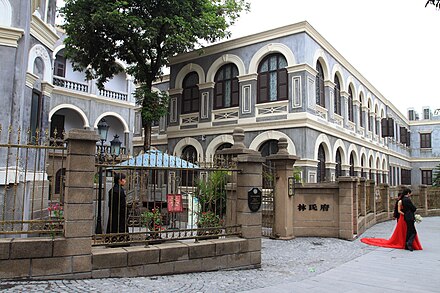 As in other International Settlements in China, the population was always predominantly Chinese but the police, the legal system, quite a few residents, and much of the architecture were foreign. All thirteen of the foreign consulates were on Gulangyu, along with houses, churches, schools, parks and a hospital. Both foreign traders and wealthy Chinese built mansions, often with large gardens, and many commercial buildings were built as well.
As in other International Settlements in China, the population was always predominantly Chinese but the police, the legal system, quite a few residents, and much of the architecture were foreign. All thirteen of the foreign consulates were on Gulangyu, along with houses, churches, schools, parks and a hospital. Both foreign traders and wealthy Chinese built mansions, often with large gardens, and many commercial buildings were built as well.
Today the island is a major tourist area; many of the old colonial-era buildings have become restaurants or guesthouses, and there are many shops geared towards tourists.
Gulangyu is sometimes called "Piano Island" and one of its attractions is music; there have been pianos on the island since the first foreign residents arrived in the 1840s. It is quite common to hear piano music (usually recorded and usually classical) in the streets as you walk about. There has been a Piano Museum for over a century, and later an Organ Museum was built as well. Both have many instruments, some dating back to the 19th century, and both have recitals for the tourists.
Read
Some readers may know the place from Neal Stephenson's novel ReamDe ; much of the story takes place in Xiamen and one character, the female British spy, has an apartment on Gulangyu. Those who do not know the novel might consider picking up a copy for on-the-road reading when heading for Xiamen.
Get in
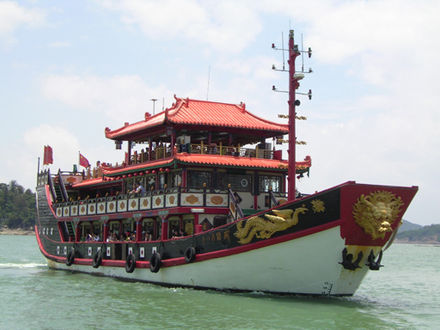 As of August 2016, the cross-harbour ferry for ¥8 is now accessible only to Xiamen residents and tickets are sold only to holders of local Xiamen ID or foreigners who have applied to have their passport registered for 'local travel'.
As of August 2016, the cross-harbour ferry for ¥8 is now accessible only to Xiamen residents and tickets are sold only to holders of local Xiamen ID or foreigners who have applied to have their passport registered for 'local travel'.
Tourists visiting Gulangyu must now buy a special tourist ticket (¥35 or ¥50 for a round trip depending on disembarkation site, 2018 price), and tickets are limited daily. Due to limited ticket quantities, you should buy your ticket online in advance if travelling during busy holiday seasons or the weekend. For example, if you were to arrive mid morning at Youlun Matou (邮轮码头) without having already purchased a ticket, it's possible you'll have to wait a few hours for a boat that has tickets available. Also: the tickets are return tickets, so be sure to hold on to your ticket after reaching Gulangyu! Return tickets are valid up to 20 days from the date of ticket purchase. You must have your passport with you when buying tickets, so do not forget it.
Tourists can travel from 3 docks to the island, depending on the time of day:
-
During daytime: Ferry from Youlun Matou (邮轮码头), located several kilometers from the center of Xiamen/main tourist area. To get there from downtown/Zhongshan area/Lundu Matou, you can take bus b1 or the special Lundu Matou tourist bus (邮轮码头旅游快线). Ferry operating times are 07:10 until 17:30 (winter) or 18:30 (summer) to Gulangyu, and 07:20 until 17:40 (winter) or 18:40 (summer) from Gulangyu back to Youlun Matou. Ferries leave multiple times per hour.
-
At night: tourists can take the ferry directly from Lundu Matou Terminal 2 (轮渡码头2号厅). This is the quickest option, yet still requires you to purchase a tourist ticket to get to the island. This service is called the Gulangyu 'Nighttime' service, and departs Lundu Matou from 17:50 (winter) or 18:50 (summer) until 06:30. Travelling from Gulangyu to Xiamen, services start 18:00 (winter) or 19:00 (winter) until 07:00. After midnight, there is only one service per hour.
-
Anytime: From the other side of Xiamen, on the mainland at Haican Song-Gu Matou (海沧嵩鼓码头). This ticket is only useful for visitors who are not already on Xiamen island. Tickets from this port are slightly cheaper at ¥30 for a return trip. Operating times are 07:30 until 17:50 (winter) or 19:00 (summer).
Ferry times change depending on the season (summer or winter). Summer season is from 1st June - 30th September. Winter season is from 1st October until 31st May.
Due to large renovations and clampdowns for the 2017 BRICS conference held in Xiamen, there are no longer any local fishermen along the wharf willing to take passengers to Gulangyu.
Ferries may be restricted or changed during the typhoon season (around September-November) or during windy weather, so check in advance for any typhoon warnings.
Get around
Cars, motorcycles and bicycles are banned, but the island is small enough to walk around as long as one is physically able. It is, however, quite hilly. Walking about, there is quite a bit of nice colonial architecture to see, much of it tucked away on back streets.
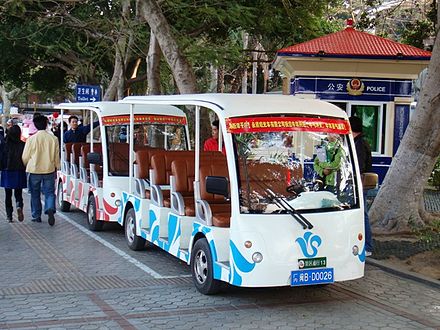
One can also hire a boat — on the Xiamen side, on Gulangyu at the docks near where the ferry comes in, or at another dock a bit north of that — for a ride around the island. This takes about an hour.
Starting from the ferry stop, most travellers either jump on a golfcart-bus for a tour or turn left onto Dragon Head Road (Longtou Lu), which is one of the main shopping streets and leads to the sights around Dragon Head Hill. An alternative is to walk straight ahead, heading inland; this gets you to a large map of the island, then to the local tourist information office (which has a left luggage service), to one of the few banks on the island, and to another shopping area. Off to the left as you walk inland are a set of steps which lead up into a pleasant area with several guesthouses and a number of restaurants.
See
A combo ticket can be bought on the island for ¥110 (2019), which gives entry to Bright Moon Garden, Shuzhuang Garden, Sunlight Rock (including cable car ride), the Piano Museum, the Organ Museum and the International Calligraphic Carving Art Gallery.
Museums and monuments
Art museums and galleries
- Celebrity World Wax Museum & 3D Art Museum (世界名人蜡像·3D艺术馆), 111 Lujiao Road (鹿礁路111号), 24.4471010942°, 118.0702296944°, +86 592 2064908. Daily 08:30-18:30. Includes waxworks of famous people from around the world. ¥60
- Gulangyu International Calligraphic Carving Art Gallery (鼓浪屿国际刻字艺术馆), 7 Gangzihou Road (港仔后路7号), 24.4427630942°, 118.0642146944°, +86 592 2068251. 08:15-17:45 (winter), 08:15-18:15 (summer). A small gallery of carved calligraphy from Chinese, Japanese, and Korean artists. Entrance near the main gate of Shuzhuang Garden. Admission normally ¥10
- Oriental Fishbone Gallery (东方鱼骨艺术馆, Xiamen Eastern Fishbone Gallery), No 27 Guxin Road (鼓新路27号), 24.4492028302°, 118.0635580229°, +86 592 2571269, lnbart@163.com. 09:00-17:00. Includes personalized explanations of every art-piece and autograph of the artist. ¥60
- Red Carpet Wax Museum (红地毯趣味蜡像馆), 2nd Floor, Bank of China building, 3 Longtou Road (龙头路3号中国银行2层), 24.4481210942°, 118.0677966944°, +86 592 2064733. 09:00-22:30. ¥60
History and culture museums
- China Records Museum (中国唱片博物馆), 32 Fujian Road (福建路32号), 24.4459330942°, 118.0681786944°, +86 592 6883070, info@crmuseum.com. 09:00-17:30. ¥78 2019-02-09
- Gulangyu 100 Years Museum (百年鼓浪屿博物馆), 62 Fujian Road (福建路62号) (Inland and uphill from the ferry stop), 24.4464600942°, 118.0666006944°, +86 18659236520. 08:00-18:00. A museum focusing on the colonial-era foreign residents of Gulangyu, in a building that was once a villa belonging to the Singapore-based OCBC Bank. ¥70
- Gulangyu Organ Museum (鼓浪屿风琴博物馆), 43 Guxin Road (鼓新路43号), 24.4497430942°, 118.0636276944°, +86 592 2061777, +86 592 2063226. 08:15-17:45 (winter), 08:15-18:15 (summer). The organ museum is in the Trigram House (八卦楼 Bagualou) in northwestern Gulangyu; it is the only and the largest organ museum in the world. Matched with the piano museum in southeastern Shuzhuang Garden, it attracts a lot of music lovers from around the world. There are many styles of organ collected in this museum. ¥20
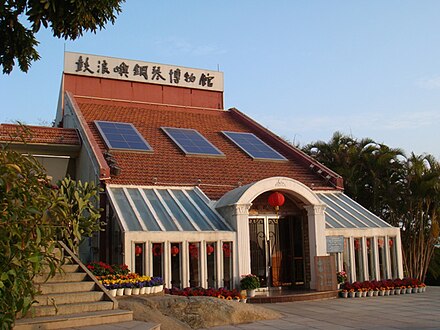
- Gulangyu Piano Museum (鼓浪屿钢琴博物馆), Shuzhuang Garden, 7 Gangzihou Road (港仔后路7号菽庄花园内), 24.4409031084°, 118.0648465265°, +86 592 2060238. 08:15-17:45 (winter), 08:15-18:15 (summer). A museum of pianos, including rare specimens from the 1700s. The entry fee to Shuzhuang Garden (normally ¥30) includes entrance to the museum. Guided tours several times a day include performances on a few of the instruments.
- Koxinga Memorial Museum (郑成功纪念馆, Koxinga Memorial Hall), 73 Yongchun Road (永春路73号), 24.445434°, 118.061941°, +86 592 2061921, +86 592 2571857. Tu-Su 08:30-16:45. A museum dedicted to Zheng Chenggong, or Koxinga as he is generally known in the West, who made his mark in history by driving the Dutch out of Taiwan in the 1660s. His headquarters were on Dragon Head Hill at the south end of Gulangyu; a watchtower and some other fortifications remain, and the statue is nearby (see listing below).
Having defeated the foreign devils, Koxinga is one of the few people regarded as a hero by the current governments of both China and Taiwan. Things the official Chinese accounts do not mention are that his father, a seafaring merchant from the Quanzhou area, dabbled in piracy and that his mother was Japanese. As the Manchu conquerors of the Qing dynasty moved south, the father surrendered and became a Qing official, but the son remained loyal to the Ming and fought on; at one point, his armies got as far as menacing Nanjing.
Eventually, he found himself defeated on the mainland so he went off, bringing most of his army, and took over Taiwan. Koxinga's arrival was the first major Chinese incursion into Taiwan; many of his troops stayed and settled. This was followed by a surge of other immigration, mainly from the Xiamen, Quanzhou and Zhangzhou areas. Modern Taiwanese is essentially the Minnan dialect of those cities. Free 2019-02-09 - Statue of Koxinga (郑成功石雕像), Bright Moon Garden (皓月园), 3 Zhangzhou Road (漳州路3号) (5 minutes walk southeast of the ferry terminal), 24.4438960942°, 118.0717846944°, +86 592 2061777. 07:30-20:30 (winter), 07:30-21:00 (summer). A 24-metre-high statue of Koxinga stands on a cliff looking toward Xiamen Island. ¥15 (Bright Moon Garden entry fee)
- Kulangsu Gallery of Foreign Artefacts from the Palace Museum Collection (故宫鼓浪屿外国文物馆), 80 Guxin Road (鼓新路80号) (on the north side of the island), 24.4542194641°, 118.0624599969°, +86 592 2919760. Tu-Su 09:00-17:00, no entry after 16:30. Occupies a heritage-listed 19th-century building, which used to be the site of the Hope Hospital and Nurses’ School. The museum was jointly founded by the Palace Museum in Beijing and the Xiamen government. As the name says, the museum displays foreign artefacts from the Palace Museum's collection. ¥50 2019-02-09
Other museums
- Shell Dream World (贝壳梦幻世界), 5 Gusheng Road (鼓声路5号), 24.4439758302°, 118.0590290229°, +86 592 2066852. 08:30-18:00 (summer), 08:30-17:20 (winter). Part theme park, part museum. The museum is said to contain over 6800 varieties of seashells from over 60 different countries. ¥78 (standard adult entry fee), ¥40 (persons aged between 60 and 69 as well as children between 1.2 and 1.5 metres in height). Children under 1.2 metres in height and persons over 70 years old are admitted for free. Tickets are cheaper if purchased online 2019-02-09
Parks and nature
- Bright Moon Garden (皓月园), 3 Zhangzhou Road (漳州路3号), 24.4446110942°, 118.0706796944°, +86 592 2061777. 07:30-20:30 (winter), 07:30-21:00 (summer). Bright Moon Garden (Haoyueyuan) is on the Covering Rock (Fudingyan) on the east (Xiamen side) coast of Gulangyu. It covers an area of 3 hectares (30,000 square meters, about 7.5 acres) spreading along the shore with a sandy beach, rocks, trees and pavilions. Its name is from two lines of a poem about a King of Yanping. In the park stands a bronze sculpture of Koxinga (Zheng Chenggong) and some of his soldiers, 13.7 meters long and 4.7 meters high (about 45 by 15 feet). ¥15
- Gulangyu Aviary (鼓浪屿百鸟园), Gusheng Road (鼓声路) (Accessible by cable car from Sunlight Rock), 24.4440428302°, 118.0594700229°, +86 592 2060777, +86 592 2062868. 07:00-20:00. Over 1000 birds from over 100 countries. Many peacocks, including a rare Albino, several types of cranes, lots of ducks/geese, and other large birds (e.g. emus). Watch for falling excrement. Aviary performances take place several times per day, including at 09:30, 10:30, 11:30, 14:00, 15:00 and 16:00. ¥60 (Sunlight Rock admission fee)
- Shuzhuang Garden (菽庄花园), 7 Gangzihou Road (港后路7号) (on the left as you walk from the ferry terminal toward sunlight rock), 24.4415340942°, 118.0647946944°, +86 592 2061777, +86 592 2063722. 07:30-20:30 (winter), 07:30-21:00 (summer). Named after the original owner Lin Erjia (aka ShuZhuang), a wealthy Taiwanese businessman who fled here when Japan took Taiwan in the 1890s. Highlights include the 44 bridge, the Piano Museum (see below) and the rockery with hidden sculptures of all 12 zodiac animals. There is also a small private art museum to the right of the main entrance. ¥30
- Xiamen Underwater World (厦门海底世界), 2 Longtou Road (龙头路2号) (from the ferry terminal, walk to the right and look for the big blue building), 24.4488280942°, 118.0663776944°, +86 592 2069365, info@xm-underwaterworld.com. 08:00-21:00 (April to October), 08:00-18:30 (November to March), no entry or ticket sales during last hour of operations. Admission is a steep ¥90 for adults, ¥50 for children/seniors, but you can just stand outside and take photos of the Jules Verne-esque octopus statue.
With a view
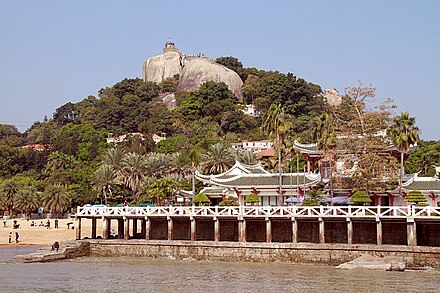
- Sunlight Rock (日光岩), 62 Huangyan Road (晃岩路62号) (on Dragon Head Hill), 24.4449598302°, 118.0624120229°, +86 592 2061777, +86 592 2067284, +86 592 2062868. 07:30-20:30 (winter), 07:30-21:00 (summer). This is the highest point on the island with great views as far as Xiamen. Entry included into Buddhist temple, the Aviary and a cable car ride to the aviary on Yingxiong Hill. Warning: climbing to the top involves a lot of stairs, so probably not good for young children or the elderly. ¥60
Other sights
- Xiamen Academy of Arts and Design (Gulangyu Campus) - Fuzhou University (福州大学厦门工艺美术学院(鼓浪屿校区)), 151 Kangtai Road (康泰路151号) (on the west side of the island), 24.4481958302°, 118.0563120229°. Has some beautiful granite sculptures. A very old Buddhist temple is nearby.
The south end of the island also has some lovely gardens with a lot of various types of eucalyptus.
There are over 50 registered heritage properties on the island. Photos and descriptions of each one can be found on the official Gulangyu World Heritage Site website (dead link: January 2023).
Do
There is a beach just south of the ferry stop and others around on the other side of the island.
 Try walking all the way around the island. The distance is about 4 km (2.5 miles) and there are good paths. If you decide to give up, just jump on a golfcart taxi; they circle the island near the coast, and come along quite often. Alternately, just ride a golfcart taxi or a boat around the island.
Try walking all the way around the island. The distance is about 4 km (2.5 miles) and there are good paths. If you decide to give up, just jump on a golfcart taxi; they circle the island near the coast, and come along quite often. Alternately, just ride a golfcart taxi or a boat around the island.
Get lost. Get away from the tour groups by getting lost in the back streets of Gulangyu which have some fascinating architecture. It is fairly easy to get lost, usually by wandering into a residential district. This can be confusing, especially if one does not speak the local language, Minnan Hua. There are an awful lot of narrow winding streets. However the island is fairly small, walking downhill will always get you to the coast, and there are paths and golfcart-type transport all along the coast, so getting lost is annoying at worst.
- Gulangyu Concert Hall (鼓浪屿音乐厅), 1 Huangyan Road (晃岩路1号), 24.4455200942°, 118.0664856944°, +86 592 2066730. Concerts are held here almost every night at 19:30. Most concerts are free 2019-02-10
Buy
Items aimed at the tourist trade abound on Gulangyu — some amazingly tacky, some amazingly lovely, and more-or-less everything between.
As in any tourist area in Asia, many things are much cheaper than in western countries but asking prices tend to be high and bargaining is usually necessary. Gulangyu merchants have some excuse for high prices; they have to cover costs of transporting goods to the island. In general, things are more expensive on Gulangyu than in downtown Xiamen; on the other hand Gulangyu has a much broader range of tourist merchandise and a better selection on some items.
The two main shopping streets are Dragon Head Road (Longtou Lu) — which runs south near the shore from the ferry stop, off to your left as you arrive, to Dragon Head Hill or Sunlight Rock — and Quanzhou Road which is roughly parallel to that but further inland and on higher ground. There are many smaller streets with shops, mostly running off those two.
Shops along these streets sell mainly art and handicrafts. Items on offer include: beads, lacquer work, sculptures, pictures carved on stone, Chinese antiques, reproductions of Chinese antiques, jade, fake jade, other jewelry, silk and other clothing, and ceramics. There are also T-shirts, hats and other tourist merchandise, plus artists offering portraits or cartoons.
Eat
The island caters to tourists so there are lots of places to eat but many are not particularly good because the proprietors are not worried about attracting repeat business. Some are excellent, though. Expect to pay more than in Xiamen (¥100/meal for 2).
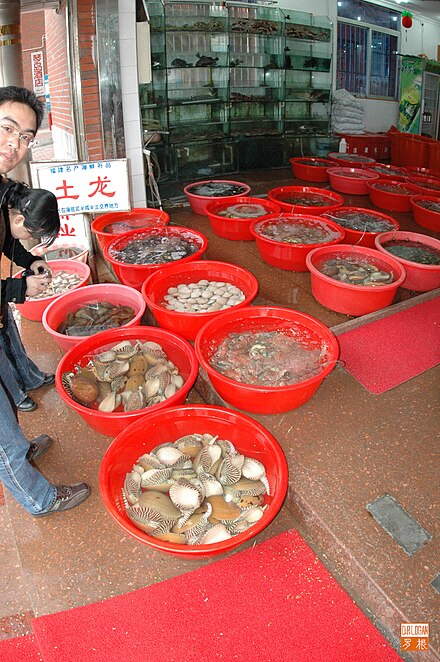 If you enjoy seafood, you may be pleasantly surprised, as Gulang Yu's local cuisine tends to emphasize seafood. The streets are lined with restaurants and food stalls that sell a variety of such dishes (look for red plastic tubs of fresh seafood). If you're more interested in a sweeter snack, there's a great ice cream place near the ferry's drop off point. Prices are higher than in Xiamen.
If you enjoy seafood, you may be pleasantly surprised, as Gulang Yu's local cuisine tends to emphasize seafood. The streets are lined with restaurants and food stalls that sell a variety of such dishes (look for red plastic tubs of fresh seafood). If you're more interested in a sweeter snack, there's a great ice cream place near the ferry's drop off point. Prices are higher than in Xiamen.
- Yuanxiangkou Fish Balls (原 巷 口), four locations around Gulangyu; one is behind the ICBC near the ferry terminal, +86 592-3997993. An award-winning shop that is most famous for its fish balls, which are stuffed with pork and cooked in a savory soup. Try the fish balls alone (¥6) or with noodles (¥8). Unless you're an adventurous foodie and/or read Chinese well enough to understand exactly what you're getting, however, skip the other "snacks" (小 吃) even though they're supposed to be famous Gulangyu specialties.
- Shirley Valentine. Serves fresh fish and noodles. Recommended are the mussels with noodles and green tea. A seat under an umbrella on the sea shore is a must.
- Chu Family Coffee, 15 Zhonghua Rd, +86 13600944308. Quiet and lovely place. They offer coffee, western-style food and desserts. A bit overpriced, like many of the venues on Gulangyu.
- DeGuo Sausage, LonTouLu 178 GuLangYu / 龙头路178, +86 147 5926 8410. 10:00-20:00. A Bratwurst (German sausage) restaurant run by a few expat Germans. ¥25 Not far inland of the ferry stop is a large building with some interesting upmarket tourist shops and several restaurants including a large KFC on ground level and a place on the second floor that has reasonable food, good beer, and a patio with a fine view. There is a central courtyard that sometimes has acrobats, jugglers or musicians.
Near that is the main market for Gulangyu residents, mainly selling fruits, vegetables and seafood. Nothing is cooked, nobody speaks English, and some prices are higher than downtown Xiamen, but the place can be an adventure and a pile of fruit here will be cheaper than lunch in a restaurant.
Drink
- Black Cat Coffee (Black Cat Cafe), 14 Yong Chun Rd. You can come just for the coffee (~¥30-35) and a look at the restored home and gardens, but definitely consider their food menu. They offer a la carte options for seafood and mixed grill items for ¥100-140, and 4-course set menus for ¥160-190. The "Italian consulate menu" is good. It consists of a crisp roast duck caesar salad, a sweet and creamy pumpkin soup, choice of prime rib or salmon, and dessert. The front porch tables enjoy sun after 13:00, and American oldies play on speakers throughout the cafe. ¥30-200
Sleep
There are numerous places to stay on Gulangyu, mostly at moderate prices. As of 2018, many hotels in the area do not accept foreigners— make sure you book ahead of time and confirm that the hotel accepts foreigners before showing up. Near the ferry wharf there are several places within a stone's throw of each other. When you get off the ferry, walk straight. Immediately on your left, you will see a stone stairway leading to the top of a small hill. At the top, turn right onto Lujiao Road and you will find a youth hostel and several hotels.
- {{sleep | name=Bayview Inn | url=http://www.bayviewinn.cn (dead link: December 2020) | email=bayviewinn@163.com | address=17 Longtou Rd | lat= | long= | directions=Once on Lujiao Road (see above) look for a yellow/white building and a sign. | phone=+86 592 2060466, +86 592 2060468 | tollfree= | fax=+86 592 2060468 | hours= | price=¥45-60 dorm, ¥188 twin, ¥322 twin ensuite | checkin= | checkout=12:00 | content=Very nice, clean inn near the ferry terminal. Free internet and wi-fi. English speaking staff. The website is in Chinese but there are detailed pictures of all the rooms on the site. Air-con and mosquito plug-ins provided. }}
- Consulate Inn (former British Consulate), 14 Lujiao Rd (South and inland from the ferry terminal), +86-592-2068305.
- Gulangyu International Youth Hostel, 18 Lujiao Rd, +86 592-2066066, yha@yhagly.com. Just up the road from 'Naya'. Spacious grounds. Grubby dorms, iffy bathrooms. Peeling paint. No kitchen. Better go to Bayview Inn across the street for a few yuan more, or stay at Xiamen International Youth Hostel, 41 Nanhua Road, on the mainland, which is impeccable. (City bus 1 or 21 from the railway station.)
- {{sleep | name=Just a Hotel | alt=有间客栈 - You Jian Ke Zhan | url=http://www.youjian-hotel.com (dead link: December 2020) | email= | address= | lat= | long= | directions= | phone=+86 592-2066088 | tollfree= | fax= | checkin= | checkout= | price=From ¥168 to 260 | content=A nice and cozy hotel on Gulang Yu. Really friendly staff and a nice boss "Jason". If you don't find the place, give them a call. Family-style, private bathrooms. }}
- Naya Home Hotel (former German Consulate), Lujiao Road. Wonderful homestyle hotel, quaint decoration. Also doubles as an Italian restaurant/cafe with outdoor seating. No individual dorms.
- Remy's Garden Hotel, No.65 Kantai Rd (over on the west side of the island).
Go next
For most travellers, the only place you can go from Gulangyu is back to Xiamen.
If you own or charter a boat, there are other choices but some caution is required. The Taiwan-controlled island of Kinmen is nearby and — while there has not been artillery fire across that strait since the 1970s, — both governments still consider the area sensitive and keep substantial military forces there.
Fujian
Primary administrative division
